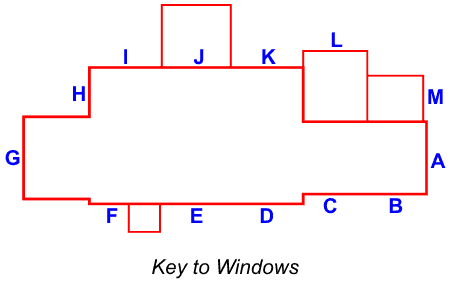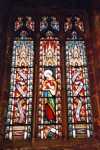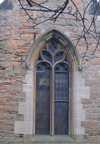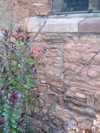Nuthall St PatrickGlass

 AEast
window of chancel. Triple lancet with panel tracery. Three lights with late
15th century Crucifixion scene, figures of Our Lord on the Cross flanked
by Our Lady and St John. Below are shields containing the arms of the
Greys of Codnor, Morley and D’arcy. The window was restored in 1853,
retaining much of the original glass. AEast
window of chancel. Triple lancet with panel tracery. Three lights with late
15th century Crucifixion scene, figures of Our Lord on the Cross flanked
by Our Lady and St John. Below are shields containing the arms of the
Greys of Codnor, Morley and D’arcy. The window was restored in 1853,
retaining much of the original glass.
The inscription in the glass at the base of the window reads:
| THIS ANCIENT WINDOW WAS REMOVED FROM THE EAST END OF THE SOUTH AISLE
AND RESTORED BY Wm WARRINGTON LONDON
1853 FOR THE HONble AND REVd JOHN
VENABLES VERNON RECTOR. |
Truman praises the glass very highly.
In 1819 Stretton describes such a window
(Crucifixion and shields) in the east window of the chapel of St Mary,
or north aisle before it was removed to its present position in the chancel
in 1853. The Nixon memorial window replaced it at the
east end of the north aisle. (There is no south aisle.) However, when the
east wall and window of the aisle were removed during the 1884 renovations,
the Nixon window was resited to its present position at the western end of
the north aisle.
BThe eastern most window
on the chancel south wall. Late 14th century, restored double lancet with
decorated tracery and square reveals. Pevsner says
that such windows are very characteristic of village churches in the district,
giving a date of c1400. The glass is made up of 19th century, pastel coloured,
yellow, blue and pink, diamond shaped panes modern glass.
 CThe
second chancel window on the south wall. Double lancet and tracery, reveals
and date corresponds with window B. The stained glass,
similar in date to the shields in the east window, (ie most
probably pre-Reformation), are of arms of the Calthrop, Le Gros and Howard
families, plus a further shield made up of unidentifiable fragments. The
families so represented are not known to be connected with St Patrick’s
or Nuthall and it has been speculated that these heraldic shields may have
come from Lenton Priory at the time of its dissolution. CThe
second chancel window on the south wall. Double lancet and tracery, reveals
and date corresponds with window B. The stained glass,
similar in date to the shields in the east window, (ie most
probably pre-Reformation), are of arms of the Calthrop, Le Gros and Howard
families, plus a further shield made up of unidentifiable fragments. The
families so represented are not known to be connected with St Patrick’s
or Nuthall and it has been speculated that these heraldic shields may have
come from Lenton Priory at the time of its dissolution.
Spooner reasonably speculates
that pre-1884 there would have been corresponding windows on the north chancel
wall, but Stretton makes no mention of such
on his visit in 1819 whilst recording all other windows, nor does the wording
of the 1884 faculty.
The three south nave windows (D, E and F on the plan) are
all double lancet windows with decorated tracery and square reveals.
 DThe
modern glass in this window, the most easterly of the nave windows, has pleasing
full-length representations of St George and of St Martin. The
window is dedicated, on the War Memorial plaque below,
to those who died in the 1914-18 war. DThe
modern glass in this window, the most easterly of the nave windows, has pleasing
full-length representations of St George and of St Martin. The
window is dedicated, on the War Memorial plaque below,
to those who died in the 1914-18 war.
 EThe
middle window poignantly depicts, in the left light, St Elizabeth,
wearing a crown, offering flowers to a young man kneeling at her feet,
and the words “This is my beloved”. EThe
middle window poignantly depicts, in the left light, St Elizabeth,
wearing a crown, offering flowers to a young man kneeling at her feet,
and the words “This is my beloved”.
According to the legend, St Elizabeth of Hungary defied her husband,
the king, in taking bread in her apron skirt to feed the poor. When accosted,
the bread had changed into roses, so becoming her emblem and accounting
for all the flowers seen in the stained glass (delphiniums, iris, harebell,
lilies, roses, primroses, asters, pansies, violets, marigolds and anemones).
There is a more orthodox representation of the Virgin and Child, in the
second light.
The inscription reads:
| IN LOVING MEMORY OF WILLIAM BANNER HANSON AND ELIZABETH COCKBURN,
HIS WIFE AND OF RONALD BANNER, THEIR SON. THIS WINDOW WAS ERECTED
A.D. 1932 |
The window was designed and installed by F J Eden. London.
Holden described the window as”planned
to let in as much light as possible - vivid splashes of colour to give
a jewelled effect not commonly found in stained glass work.”
FThe third window, west
of the south porch door has plain leaded squares of glass in pastel colours
of yellow, blue and pink.
 GTower
window. An early photograph of the church
in 1867, shows the tower without a window. The present window was inserted
in 1884. It has a double lancet with flowing tracery and has a hoodmould.
The glass, of plain leaded squares in pastel shades of yellow, blue and pink,
has now been replaced by a new stained glass window installed in 2003. The
new window portrays the arms of the Bramley family in one light, and a farmer
sowing seed in the other, representing the parable of the sower and the farming
connection of the Bramley family. Behind both lights Broxtowe Hall (now demolished)
is depicted. The thicket of brambles, a rebus on the family name, together
with the badgers or brocks, a play on the Broxtowe Hall connection, is cleverly
incorporated into the glass. The family timber business is commemorated by
the two abstract tree patterns which border the window. At the base of the
window the inscription is: GTower
window. An early photograph of the church
in 1867, shows the tower without a window. The present window was inserted
in 1884. It has a double lancet with flowing tracery and has a hoodmould.
The glass, of plain leaded squares in pastel shades of yellow, blue and pink,
has now been replaced by a new stained glass window installed in 2003. The
new window portrays the arms of the Bramley family in one light, and a farmer
sowing seed in the other, representing the parable of the sower and the farming
connection of the Bramley family. Behind both lights Broxtowe Hall (now demolished)
is depicted. The thicket of brambles, a rebus on the family name, together
with the badgers or brocks, a play on the Broxtowe Hall connection, is cleverly
incorporated into the glass. The family timber business is commemorated by
the two abstract tree patterns which border the window. At the base of the
window the inscription is:
| Unto you is given to know the mysteries of the kingdom, Mark 4:11 |
The dedication below the window reads:
| IN MEMORY OF CHARLES HUBERT VINCENT BRAMLEY, CHARLES EDWARD BRAMLEY,
ROSA BRAMLEY. |
It is the work of Jonathan Watts.
 HWest
window in the north aisle. 15th century, triple lancet with panel tracery,
gothic-style, The central light depicts the figure of a lady holding an urn.
The dedication, in the form of a banner-like scroll, takes up the two outer
lights and reads: HWest
window in the north aisle. 15th century, triple lancet with panel tracery,
gothic-style, The central light depicts the figure of a lady holding an urn.
The dedication, in the form of a banner-like scroll, takes up the two outer
lights and reads:
| TO THOMAS NIXON OF NUTTALL WHO DIED APRIL 13th 1853, AGED 85. THIS
MEMORIAL WAS ERECTED BY HIS WIDOW |
The small three sections at the base of the glass have:
| i |
|
“Why seek ye the living among the dead.” |
| ii |
|
The shield of the Nixon family |
| iii |
|
“He is not here but risen.” |
The colour of the glass in this window is of fine quality. This window had
previously been sited at the eastern end of the north aisle close to the Nixon
memorial tablet and the Nixon vault. It was moved to its present position
in 1884.
I,J,KThree windows on
the north wall of the north aisle. Each a double lancet with square reveals.
19th century, diamond leaded panes of pastel glass yellow, blue and pink.
The middle window is blocked on the exterior by the new
choir vestry.
 LThe
north side of the 1884 vestry has a double lancet decorated window with hoodmould
and mask stops. The glass is plain and hidden on the inner side by the organ
chamber and janitor’s closet. LThe
north side of the 1884 vestry has a double lancet decorated window with hoodmould
and mask stops. The glass is plain and hidden on the inner side by the organ
chamber and janitor’s closet.
MThe window on the east
wall of the 1884 vestry has a 15th century-style double lancet with a hoodmould
and is of plain glass. Further windows, all plain glass, are to be found
in the choir vestry.
 Also
of interest is a small, low-lying, oblong shaped window, now blocked, which
can be seen on the exterior south wall of the chancel, near the east end of
the nave, below Window C. Often erroneously termed a leper’s
squint, more possibly a sacring-bell window. Also
of interest is a small, low-lying, oblong shaped window, now blocked, which
can be seen on the exterior south wall of the chancel, near the east end of
the nave, below Window C. Often erroneously termed a leper’s
squint, more possibly a sacring-bell window.
Mee, c1900, described the windows of
the church
“[the] window tracery is what is known as Flowing Decorated, approaching
flamboyant.”
| 
















